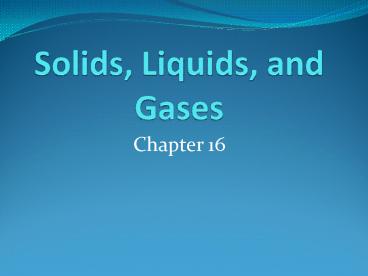Solids, Liquids, and Gases - PowerPoint PPT Presentation
1 / 34
Title:
Solids, Liquids, and Gases
Description:
... higher KE Classified as a fluid because it can flow Liquid Properties Surface Tension ... Characteristics of Gases ... shape or volume stars, ... – PowerPoint PPT presentation
Number of Views:166
Avg rating:3.0/5.0
Title: Solids, Liquids, and Gases
1
Solids, Liquids, and Gases
- Chapter 16
2
Kinetic Theory
- All matter is made of atoms and molecules that
act like tiny particles - These particles are always in motion. The higher
the temperature, the faster they move - At the same temp., more massive particles move
slower than less massive particles
3
Kinetic Molecular Theory
- Particles in an ideal gas
- have no volume
- have elastic collisions
- are in constant, random, straight-line motion
- dont attract or repel each other
4
States of Matter
- Solid definite volume, definite shape
- Liquid definite volume, no definite shape
- Gas no definite volume, no definite shape
- Plasma gas-like, no definiteshape or volume
5
Solids
- Have a rigid structure
- Particles have almost no freedom to change
position, low KE - Still vibrate around a fixed location
6
Types of Solids
- Crystalline - repeating geometric pattern
- covalent network
- metallic
- ionic
- covalent molecular
- Amorphous - no geometric pattern
7
Types of Solids
Ionic (NaCl)
Metallic
8
Types of Solids
Covalent Molecular (H2O)
Covalent Network (SiO2 - quartz)
Amorphous (SiO2 - glass)
9
Liquids
- Take the shape of their container
- Particles are held close together, but not
attracted as strongly as particles in a solid,
higher KE - Classified as a fluid because it can flow
10
Liquid Properties
- Surface Tension
- attractive force between particles in a liquid
that minimizes surface area
11
Liquid Properties
- Capillary Action
- attractive force between the surface of a liquid
and the surface of a solid
12
Liquids vs. Solids
- LIQUIDS
- Stronger than in gases
- Y
- high
- N
- slower than in gases
- SOLIDS
- Very strong
- N
- high
- N
- extremely slow
IMF Strength Fluid Density Compressible Diffusio
n
13
Gases
- Free to spread in all directions
- Under standard conditions, gas particles move
rapidly, high KE - Exert pressure, but can be compressed into a
smaller volume
14
Real Gases
- Particles in a REAL gas
- have their own volume
- attract each other
- Gas behavior is most ideal
- at low pressures
- at high temperatures
- in nonpolar atoms/molecules
15
Characteristics of Gases
- Gases expand to fill any container
- random motion, no attraction
- Gases are fluids (like liquids)
- no attraction
- Gases have very low densities
- no volume lots of empty space
16
Characteristics of Gases
- Gases can be compressed
- no volume lots of empty space
- Gases undergo diffusion effusion
- random motion
17
Describing Gases
- Gases can be described by their
- Temperature----K
- Pressure----atm
- Volume---L
- Number of molecules/moles----
18
Temperature
- Always use absolute temperature (Kelvin) when
working with gases!
19
Plasma
- very high KE - particles collide with enough
energy to break into charged particles (/-) - gas-like, no definiteshape or volume
- stars, fluorescentlight bulbs, TV tubes
20
Thermal Expansion
- Most matter expands when heated contracts when
cooled - ? Temp causes ? KE - Particles collide with more
force spread out - Examples
- Sidewalk dividers
- Thermometers
21
Changes of State
- Changing states of matter requires energy
22
Changes of State
- Evaporation
- Condensation
- Melting
- Freezing
- Sublimation
- Liquid -gt Gas
- Gas -gt Liquid
- Solid -gt Liquid
- Liquid -gt Solid
- Solid -gt Gas
23
Phase Changes
24
Phase Changes
- Evaporation
- molecules at the surface gain enough energy to
overcome IMF - Volatility
- measure of evaporation rate
- depends on temp IMF
25
Phase Changes
- Equilibrium
- trapped molecules reach a balance between
evaporation condensation
26
Phase Changes
p.478
- Vapor Pressure
- pressure of vapor above a liquid at equilibrium
v.p.
- depends on temp IMF
- directly related to volatility
temp
27
Phase Changes
- Boiling Point
- temp at which v.p. of liquid equals external
pressure
- depends on Patm IMF
- Normal B.P. - b.p. at 1 atm
28
Phase Changes
- Melting Point
- equal to freezing point
- Which has a higher m.p.?
- polar or nonpolar?
- covalent or ionic?
polar
ionic
29
Phase Changes
- Sublimation
- solid ? gas
- v.p. of solid equals external pressure
- EX dry ice, mothballs, solid air fresheners
30
Heating Curves
31
Heating Curves
- Temperature Change
- change in KE (molecular motion)
- depends on heat capacity
- Heat Capacity
- energy required to raise the temp of 1 gram of a
substance by 1C - Specific heat - different values for each
substance
32
Heating Curves
- Phase Change
- change in PE (molecular arrangement)
- temp remains constant
- Heat of Fusion (?Hfus)
- energy required to melt 1 gram of a substance at
its m.p.
33
Heating Curves
- Heat of Vaporization (?Hvap)
- energy required to boil 1 gram of a substance at
its b.p. - usually larger than ?Hfuswhy?
- EX sweating, steam burns
34
Heating Curve
- Video Clip

